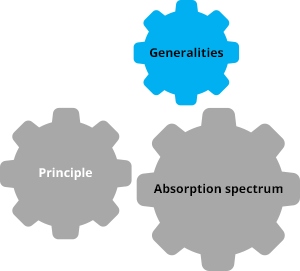Basics of UV-visible absorption spectroscopy
Generalities
Absorption spectroscopy is a technique based on the interaction between radiation and matter. It allows the characterization and quantification of liquids, solids and gases.
Generally, wavelength ranges probed are:
- 200 to 400 nm for ultra-violet (UV)
- 400 to 800 nm for the visible region (this range of wavelength is related to the colour of a molecule)
- > 800 nm for near infra-red
- UV-A (315 – 400 nm)
- UV-B (280 - 315 nm)
- UV-C (100 - 280 nm)
- Extreme UV (10 - 100 nm)
UV-visible absorption spectroscopy is often used as a detection method for separative techniques such as liquid chromatography.





